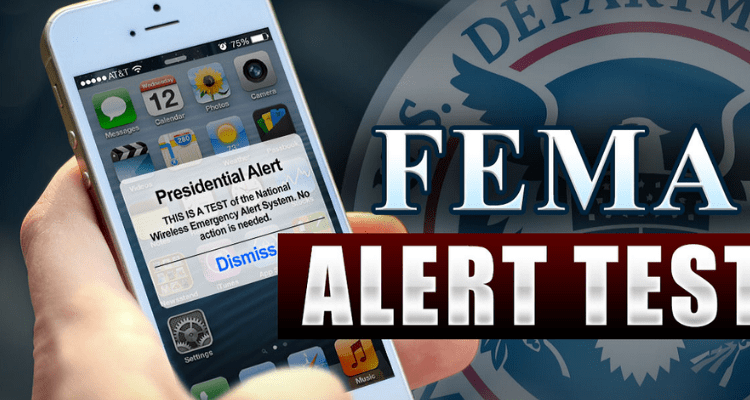By JOHN ANDERSON
Tomorrow (Wednesday, Oct. 4) at 2:20 p.m., FEMA and the FCC will conduct an Emergency Alert test on your cell phone, television and radio.
The test will try to work on your device for half an hour, and you will hear the loud alert even if you are in silent mode.
Any local schools who have a “no cell phone policy” will see if the students are following this rule. Plus, there might be some very, very loud noises from lockers in the hallway.
CONSPIRACY?
Media outlets have been inundated by questions that this is a government conspiracy.
Philip Marcelo of the Associated Press wrote that the claim is the emergency broadcast system test will activate nanoparticles such as graphene oxide that have been introduced into people’s bodies.
Marcelo and the AP said their assessment is … “False.”
The AP talked to a spokesperson for FEMA who said there are no known adverse health effects from the signal. Further, they said these claims are tied into old “long-debunked conspiracy theories about the contents of the COVID-19 vaccine.”
That has not stopped people from posting viral social media posts and videos saying this test will trigger the oxide, which is not used in covid vaccines.
One scientist was so stunned, she told the AP, “You can’t ‘activate’ graphene oxide,” she wrote. “What does that even mean?”
STOPPING THE TEST
The test will try to work on your phone, TV or radio for 30 minutes, then it’s supposed to give up.
The only way to stop the test is to turn your cell phone off or put it in airplane mode.
There are some experts who think the test won’t take place if you are only connected to WiFi.
What does the Government say?
Since the government put this together, we may as well let them have their say.
Here is the full press release:
WASHINGTON — FEMA, in coordination with the Federal Communications Commission (FCC), will conduct a nationwide test of the Emergency Alert System (EAS) and Wireless Emergency Alerts (WEA) this fall.
The national test will consist of two portions, testing WEA and EAS capabilities. Both tests are scheduled to begin at approximately 2:20 p.m. ET on Wednesday, Oct. 4.
The WEA portion of the test will be directed to all consumer cell phones. This will be the third nationwide test, but the second test to all cellular devices. The test message will display in either English or in Spanish, depending on the language settings of the wireless handset.
The EAS portion of the test will be sent to radios and televisions. This will be the seventh nationwide EAS test.
FEMA and the FCC are coordinating with EAS participants, wireless providers, emergency managers and other stakeholders in preparation for this national test to minimize confusion and to maximize the public safety value of the test.
The purpose of the Oct. 4 test is to ensure that the systems continue to be effective means of warning the public about emergencies, particularly those on the national level. In case the Oct. 4 test is postponed due to widespread severe weather or other significant events, the back-up testing date is Oct. 11.
The WEA portion of the test will be initiated using FEMA’s Integrated Public Alert and Warning System (IPAWS), a centralized internet-based system administered by FEMA that enables authorities to send authenticated emergency messages to the public through multiple communications networks. The WEA test will be administered via a code sent to cell phones.
This year the EAS message will be disseminated as a Common Alerting Protocol (CAP) message via the Integrated Public Alert and Warning System-Open Platform for Emergency Networks (IPAWS-OPEN).
All wireless phones should receive the message only once. The following can be expected from the nationwide WEA test:
Beginning at approximately 2:20 p.m. ET, cell towers will broadcast the test for approximately 30 minutes. During this time, WEA-compatible wireless phones that are switched on, within range of an active cell tower, and whose wireless provider participates in WEA, should be capable of receiving the test message.
For consumers, the message that appears on their phones will read: “THIS IS A TEST of the National Wireless Emergency Alert System. No action is needed.”
Phones with the main menu set to Spanish will display: “ESTA ES UNA PRUEBA del Sistema Nacional de Alerta de Emergencia. No se necesita acción.”
WEA alerts are created and sent by authorized federal, state, local, tribal and territorial government agencies through IPAWS to participating wireless providers, which deliver the alerts to compatible handsets in geo-targeted areas. To help ensure that these alerts are accessible to the entire public, including people with disabilities, the alerts are accompanied by a unique tone and vibration.
Important information about the EAS test:
The EAS portion of the test is scheduled to last approximately one minute and will be conducted with the participation of radio and television broadcasters, cable systems, satellite radio and television providers and wireline video providers.
The test message will be similar to the regular monthly EAS test messages with which the public is familiar. It will state: “This is a nationwide test of the Emergency Alert System, issued by the Federal Emergency Management Agency, covering the United States from 14:20 to 14:50 hours ET. This is only a test. No action is required by the public.







